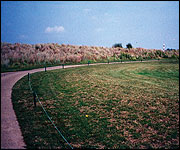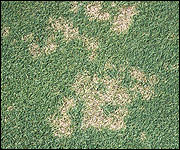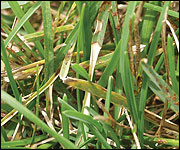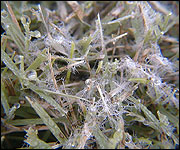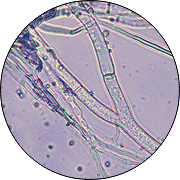Dollar spot
Symptoms and signs | Conditions | Management
Dollar spot is a common disease on creeping bentgrass, Kentucky bluegrass and perennial ryegrass, but it is rare on tall fescue. It also occurs on zoysiagrass, bermudagrass, buffalograss and annual bluegrass . The disease can occur irrespective of management program or soil fertility status, although damage is usually most severe when the turfgrass is nitrogen-deficient.
Pathogen
- Sclerotinia homoeocarpa
Hosts
- Creeping bentgrass
- Kentucky bluegrass
- Perennial ryegrass
- Zoysiagrass
- Bermudagrass
- Buffalograss
Symptoms can be confused with those of
- Ascochyta leaf blight
- Dead spot
- Brown patch
- Cutworms
Symptoms and signs
In higher cut turfgrass, Sclerotinia homoeocarpa infection results in the formation of small, roughly circular tan patches. Patch size varies with mowing height and environmental conditions and can range from a few inches to 6 inches or more in diameter (Figure 1). During extended periods of disease-favorable weather, patches coalesce into large, irregular, dead areas. Infected plants within the diseased spots wilt and eventually turn tan or brown because of girdling lesions on the leaf blades. This can result in substantial damage to the turfgrass.
On putting greens, dollar spot infection sites rarely exceed 2 inches in diameter (Figure 2). During weather that is favorable to dollar spot, hundreds of spots can coalesce to blight large areas of the putting surface. If left untreated, the spots become sunken, leaving a low-quality, pockmarked putting surface.
Foliar symptoms of dollar spot can be seen on plants at the transition zone between healthy and infected turfgrass. On Kentucky bluegrass, the lesions appear as bleached areas with a constricted or hourglass appearance, usually with reddish brown borders (Figure 3). The lesions are often located near the middle of the leaf and extend completely across the leaf blade. On creeping bentgrass, individual infected leaves exhibit light tan lesions that may or may not be surrounded by a dark, reddish-brown border (Figure 4). The lesions are difficult to see on closely mowed bentgrass without a hand lens. On warm-season grasses (bermudagrass, buffalograss and zoysiagrass) the symptoms occur as discrete lesions bordered by brown bands (Figure 5).
In the early morning when dew is still present on the turfgrass, small cottony webs of fungal mycelium can sometimes be seen growing from the diseased leaf blades (Figure 6 top). This growth can be confused with spider webs, "cotton" from plant seeds, or other fungi, and therefore is not a reliable diagnostic feature.
When viewed under a compound microscope, the fungal hyphae have a characteristic Y-shaped branching, in contrast to hyphae of Rhizoctonia solani, which are predominantly right-angled (Figure 6 bottom).
Conditions
Dollar spot is more prevalent in nitrogen-deficient turfgrass. S. homoeocarpa survives indefinitely in thatch and soil. In the presence of a thin film of moisture on leaves and moderate temperatures (65 to 85 degrees F), the fungus infects leaves. S. homoeocarpa rarely infects turfgrass roots, although fungal toxins may adversely affect root formation. Dollar spot is most severe in late spring and early summer and again in early fall; however, it can occur throughout the summer months. The patches are more numerous in areas where air circulation or soil drainage is poor.
Management
On higher cut turfgrass
The first step to reduce the negative impact of dollar spot on any cool-season turfgrass is to apply enough nitrogen at the right time to meet the needs of the turfgrass species under management.
Dollar spot is rarely serious on home lawns, but irrigation practices that extend the duration of leaf wetness can promote disease development. Irrigation of any turf, whether home lawn, fairway or green is best applied from midnight to early morning when the grass is normally wet.
A preventive fungicide application is generally not needed on home lawns. Nevertheless, dollar spot can reduce the quality of the turf for short periods. On higher cut, cool-season turfgrass on golf courses, the need for fungicides to suppress dollar spot depends on the susceptibility of the turfgrass species being managed and on the facility's expectations and budget.
On bentgrass or bentgrass/annual bluegrass greens
The first line of defense is to use a bentgrass cultivar with resistance to dollar spot. Check the National Turfgrass Evaluation Program website, ntep.org, for the most up-to-date information.
Minimize the duration of leaf wetness by physically removing dew (poling, mowing, syringing) in early morning. Do not allow the grass to go under drought stress. Maintain adequate nitrogen fertility. Biological control of dollar spot by fertilization with composted turkey litter, bovine wastes and other organic amendments has been achieved by some superintendents. However, organic amendments have not consistently reduced dollar spot incidence and severity in university research trials. Similarly, results with the addition of microbial biological control agents (fungi and bacteria) and plant defense activators have not been consistent.
Preventive fungicide applications at 7- to 21-day intervals are needed to suppress dollar spot. The timing and frequency of application depends on weather conditions and on the type of fungicide that is applied. Continuous use of xylem mobile fungicides, including thiophanate methyl and the DMI fungicides (fenarimol, myclobutanil, propiconazole and triadimefon) may result in the selection and increase of fungicide-resistant strains of S. homoeocarpa. Superintendents should consider limiting the number of applications of these fungicides during the growing season and tank mixing or alternating these products with contact fungicides not prone to resistance problems.
Many superintendents have reported that dollar spot on bentgrass or bentgrass/annual bluegrass greens is becoming more difficult to control, raising concerns about fungicide-resistant strains of S. homeoeocarpa. Careful study has shown that the lack of control is often related to fungicide application errors. One such error is application of lower fungicide rates than recommended on the product label, either intentionally to save money or accidently because of sprayer calibration issues. Another error is the attempt to extend the interval of protection beyond label recommendations. Although fungicides can suppress S. homoeocarpa, bentgrass recovery may not occur quickly. This is especially true when the bentgrass is under growth regulation and generation of new tissue is delayed.
